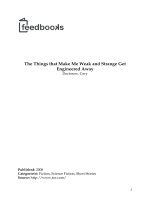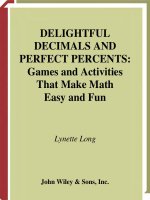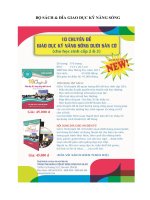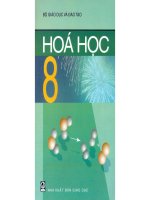Bộ sách Creative activities that make math science fun for kids Cool optical illusions
Bạn đang xem bản rút gọn của tài liệu. Xem và tải ngay bản đầy đủ của tài liệu tại đây (9.43 MB, 34 trang )
-TO LIBRAR
Y
HOW
CHECKERB
OA
RD
COOL ART WITH MATH & SCIENCE
OPTICAL ILLUSIONS
CREATIVE ACTIVITIES THAT MAKE MATH & SCIENCE
FUN FOR KIDS!
ANDERS HANSON AND ELISSA MANN
C O O L A R T W IT H MAT H & SCIEN CE
OPTICAL ILLUSIONS
CREAT IVE A C TIVITIE S T H A T M A K E M A T H
FUN FOR KIDS!
ANDERS HANSON
&
SC I E N C E
AND ELISSA MANN
V I S IT U S AT W W W. A B DO P U B LI S H I N G.CO M
Published by ABDO Publishing Company, a division of ABDO, P.O. Box 398166, Minneapolis,
Minnesota 55439. Copyright © 2014 by Abdo Consulting Group, Inc. International copyrights
reserved in all countries. No part of this book may be reproduced in any form without written
permission from the publisher. Checkerboard Library™ is a trademark and logo of ABDO Publishing
Company.
Printed in the United States of America, North Mankato, Minnesota
062013
092013
Design and Production: Anders Hanson, Mighty Media, Inc.
Series Editor: Liz Salzmann
Photo Credits: Anders Hanson, Shutterstock
LIBRARY OF CONGRESS CATALOGING-IN-PUBLICATION DATA
Hanson, Anders.
Cool optical illusions : creative activities that make math & science fun for kids! / Anders Hanson and
Elissa Mann.
p. cm. -- (Cool art with math & science)
Audience: 008-012.
Includes bibliographical references and index.
ISBN 978-1-61783-822-4
1. Optical illusions--Juvenile literature. 2. Visual perception--Juvenile literature. I. Mann, Elissa,
1990- II. Title.
QP495.H26 2014
152.14’8--dc23
2013001896
C O NT E NT S
4
6
8
10
14
16
C O O L O P T I C A L I L L U S I ONS
TRICKY I M AG ES
SEE IT ! B E L I E V E I T ?
TY P ES OF OP T I C A L I L LUSI ON S
C O LOR S
FREQU EN C I ES OF L I G HT
P RO JE C T
1
MAGIC COLOR SP I N N ER
O P P OS I T E C O L O R S
TA K E IT AS A COM P L EM EN T !
P RO JE C T
2
AFTERI M AG E I L LUSI ON S
20
22
26
30
31
31
32
3- D
OR NOT
3- D ?
TH E O B JE C TS TH AT CO U L DN ’ T B E
PROJECT
3
DRAWING IMPOSSIBLE OBJECTS
PROJECT
4
DISTORTING ILLUSIONS
M A TH TERM S
GLOS S A RY
W EB S ITES
INDEX
OPTICAL ILLUSIONS
TRICKY
IMAGES
O
ptical illusions are images that play tricks. They fool your
eyes and brain. When your eyes see an illustration, they
send information to the brain. Your brain puts the information
together. It realizes that what your eyes saw can’t be right!
4
There are many types of illusions. Some
look like real objects, like the picture above.
Look closer! It could never truly exist.
5
Some illusions seem to move. Stare
at one of the stars below. Watch the
other stars rotate.
SE E I T ! BE L I E VE I T ?
TYPES OF OPTICAL ILLUSIONS
PHYSIOLOGICAL
A physiological illusion occurs when your
eyes are overstimulated. Your eyes make
up shapes and colors that don’t exist.
HERMANN GRID
AFTERIMAGES
AMBIGUOUS
Can you see black dots inside
the white circles? They aren’t
really there!
Stare closely at this image for
10 to 20 seconds. Then look at a
white surface. What do you see?
Is this an image of a vase? Or is
it two faces?
6
COGNITIVE
Cognitive illusions begin in the brain. Certain
arrangements of shapes can trick the brain. The brain
assumes things about the image that aren’t true.
PARADOX
DISTORTING
FICTION
This shape looks like it could
exist as a real object. Take a
closer look!
None of the lines in this image
are slanted. Hard to believe?
Check it with a ruler!
Is there a white, curved triangle
on top of the other shapes? Or
is it your imagination?
7
COL O RS
FREQUENCIES OF LIGHT
C
olors are organized by frequency of light. The brain assigns colors to certain
frequencies. Low-frequency light looks red. High-frequency light looks
violet. In nature, a rainbow shows the range of light frequencies. Colors and their
frequencies can even be plotted on a line.
VISIBLE LIGHT
LOW FREQUENCY
Red
Orange
HIGH FREQUENCY
Yellow
Green
Cyan
8
Blue
Violet
FROM LINE
TO LOOP
The ends of a color line
can be joined together
to form a loop. The
brain adds the color
magenta where the
ends meet. Magenta is
made of both red and
violet frequencies. It is
between red and violet
on the loop. This loop
of colors is called the
color wheel.
THE COLOR WHEEL
Magenta
Red
Violet
Orange
Blue
Yellow
Cyan
Green
9
10
P ROJE C T
1
MAGIC COLOR
SPINNER
STUFF
Y O U´L L
NEED
đƫ WHITE POSTER
BOARD
đƫ SCISSORS
đƫ RULER
đƫ COMPASS
đƫ GLUE
đƫ PENNY
đƫ BLACK MARKER
TERMS
đƫ COLOR
đƫ FREQUENCY
đƫ CIRCLE
B
lack is the absence of color. White is all
frequencies of color. What happens when you
flash black and white before your eyes? You get a
lot of crazy colors! Try this project to see it happen.
11
3
HOW TO MAKE IT
1 Use the compass to draw two
circles on the poster board.
Keep the compass at the same
setting for both circles.
2 Cut the circles out. Glue them
together. Let the glue dry.
4
3
Use the ruler to draw a line
through the center of the circle.
4 Color half of the circle with the
black marker. Use the ruler to
keep the halves separate.
5
5
12
Draw some curved lines on
the white half of the circle.
6
6
Use scissors to make a cut in
the center of the circle. The
cut should be a little less than
¾ inch (1.9 cm) long.
7
Insert the penny halfway
into the cut.
8
7
Hold the circle by the penny.
Place it on a flat surface
and spin it like a top.
9 Watch for new colors as the
top spins. Everyone watching
will see different colors.
That’s because the colors
are created in your brain!
8
13
O PPOS IT E C O L O R S
TAKE IT AS A COMPLEMENT!
E
very color has a
complementary color.
Complementary colors are
on opposite sides of the color
wheel. Pick a color on the
wheel. Look straight across
the wheel. That color is the
complement of the color you
picked.
Magenta
Red
Violet
Orange
Blue
Yellow
Stare at a color on the wheel for
60 seconds. Then look at a plain
white wall. The complementary
color will appear! This is called
an afterimage. Afterimages
happen when your eyes tire of
seeing one color.
Cyan
Green
There are different kinds of color wheels. They are all
very similar. But some include colors used for specific
purposes such as painting or printing.
14
Stare at the pink square on the right for
60 seconds. Then look at a white surface.
A green afterimage should appear.
Afterimages work with photos too! Stare at
the image on the left for 60 seconds. Then
look at a white surface. What do you see?
15
16
PROJ E C T
2
AFTERIMAGE
ILLUSIONS
STUFF
Y O U´L L
NEED
đƫ 1 SHEET ORANGE
PAPER
đƫ 2 SHEETS WHITE
PAPER
đƫ 1 SHEET MAGENTA
PAPER
đƫ BLACK MARKER
đƫ GLUE STICK
đƫ SCISSORS
đƫ COMPUTER
đƫ IMAGE EDITING
PROGRAM
TERMS
đƫ AFTERIMAGE
đƫ COLOR
C
reate your own afterimage illusion! In this
project, you’ll learn to make afterimages in two
different ways. The colors won’t look right until you
see the afterimage!
17
đƫ TRIANGLE
đƫ CIRCLE
đƫ COMPLEMENTARY
COLOR
2
PAPER
AFTERIMAGE
1 Cut two or three triangles out
of a sheet of white paper.
3
2
Glue the triangles to
the orange paper.
3
Color in the tops of the triangles
with black marker. They should
look like mountaintops.
4 Cut a circle out of the magenta
paper. Glue it to the orange
paper above the mountains.
5 Place the second sheet of white
paper next to your picture. Stare
at the middle of your picture for
60 seconds. Then look at the white
paper. What do you see?
4
18
1
COMPUTER
AFTERIMAGE
You can make great afterimages with
a computer and an image editing
program. Adobe Photoshop is an
example of an image editing program.
1
Open any photo in the
image editing program.
2
Locate the “invert” function. In
Photoshop, it’s in the “image” menu
under “adjustments.”
3
Invert the image. This will change all
the colors to their complements.
2
4 Print the inverted image. Tape it to a
white wall. Stare at the image for
60 seconds. Then look at the
white wall. What do you see?
3
19
3- D
OR NOT
3-D?
T H E O B J E C T S T H A T C O U L D N ’T B E
T
he drawings on these pages look 3-D. But look at them
more closely. They couldn’t really exist as objects.
It takes a moment to realize that the shapes are actually
illusions. These impossible shapes can only exist on paper.
A BLIVET
IMPOSSIBLE OBJECTS
20
A blivet is one example of an impossible shape. It looks like a fork. You can see the
start of two prongs on the right side. But on the left side, there are three prongs.
How did that happen? Look closely. The middle prong is not attached to the outside
prongs. So this shape couldn’t exist.
21
22
PROJ E C T
3
DRAWING
IMPOSSIBLE
OBJECTS
STUFF
Y O U´L L
NEED
đƫ PENCIL
đƫ ERASER
đƫ PAPER
TERMS
đƫ 3-D
đƫ 2-D
đƫ TRIANGLE
đƫ PARALLEL
đƫ OVAL
đƫ HORIZONTAL
đƫ VERTICAL
I
mpossible objects are paradox illusions. The brain
wants to make them 3-D, but they can only exist in
2-D. Try drawing two of the coolest impossible objects.
The Penrose triangle and the blivet are easy and fun to
draw. Then make up your own impossible objects.
23









